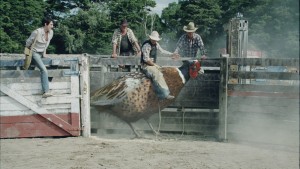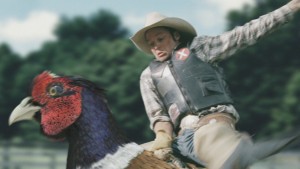For “Pheasant Rodeo,” a commercial for Britvic’s Drench Spring Water, agency CHI tasked The Mill with saddling up a cowboy on a giant bird. Ian Failes gets the feathery details from Lead 3D artist Rob van den Bragt and Flame Op Jonathan Westley.
fxg: How did the fun nature of the commercial impact on your approach to the effects?
Jonathan: There is inevitably a bit of a trade off between doing realistic effects and incorporating comic events. The more the idea is pushed, the harder it is for us to convince people that what they are seeing is real. So starting with a six foot pheasant was never going to be easy.
Rob: To ensure we got the most out of the performance the director was after, we worked on previs for a month before the shoot and another five weeks after the shoot. We didn’t sign off on the edit until two to three weeks before the deadline. Finding the balance between a natural style of performance and momentum and a cartoon style is challenging. The weight and movement has to feel right in the shots, even if certain shots are exaggerated.
 fxg: Can you tell me about what was shot for real?
fxg: Can you tell me about what was shot for real?
Rob: Since we couldn’t locate any giant pheasants anywhere on this planet, we only shot the footage for the cowboy and background plates. Often these elements weren’t shot at the same time, which meant that in order to make a shot work we had to merge the three different elements together. Due to outdoor lighting, perspective and performance, not all takes suited the needs for the shots we had in mind. Often the cowboy take was chosen and then the bird had to be inserted to match the action.
Since some shots had an over the top cowboy action, we opted to create a CG stand-in cowboy. There are about 5 shots which use the virtual cowboy. We only used a real plate for the pheasant in the close up during the stop, but even that one has CG feathers and warps. The background plates were filmed separate in order to allow the shots to be composed the way we intended and made hiding the bungee and barrel rigs less of a concern.
Jonathan: The the only thing which wasn’t shot was the pheasant. The shoot was in New Zealand and the cowboy was shot on a variety of rigs and bulls and horses to give us as many options as possible. However, in a number of shots the backgrounds have been re-created from the footage so that we could change the camera move to fit the 3D animation which worked best in the edit.
fxg: What sort of concept or art work did you look to for the commercial?
Jonathan: Over 100 previs animations were done so that the director could start to visualise which paths the bird took were funniest or the most interesting.
fxg: How did you go about modeling the pheasant? What kind of challenges did the feathers pose?
 Rob: The modeling of the actual pheasant without feathers was on the surface not a real problem, but was made more difficult by the fact that the design had to be based on various different pheasant characteristics not normally found in one pheasant. The proportions were experimented with to make the bird look more humorous. Once the shape of the bird had been decided, the feathers became the next challenge.
Rob: The modeling of the actual pheasant without feathers was on the surface not a real problem, but was made more difficult by the fact that the design had to be based on various different pheasant characteristics not normally found in one pheasant. The proportions were experimented with to make the bird look more humorous. Once the shape of the bird had been decided, the feathers became the next challenge.
The feathers on a pheasant are a blend between long and short “hair”, fluffy feathers and perfectly shaped tight multi-coloured feathers. All of them needed to have a level of interaction between them and all of them needed to be assigned manually as the chosen pheasant had a very varied and complex look blending all sorts of colour gradients and patterns. Moreover we had to deal with folded and spread wings. And not to mention that the pheasant would be seen in close-up shots in HD.
Since even the most advanced systems in the world still can’t simulate a thick volume of feathers, we designed a special character rig which was able to maintain the volume of a feathered pheasant and then in a post-process attach the visible parts of the feathers on the surface. To the eye this looks just as real as if we had simulated the feathers. At the click of a button we were able to attach each feather one by one, adjust the inclination to avoid penetration, add a ruffled look around the neck and then bake out the animation. The system created a predictable result and took only about 1 minute per frame. Without it, we would have not been able to create 23 pheasant shots.
fxg: What approach did you take to animating, lighting and rendering the pheasant and the digital cowboy where necessary?
Rob: As mentioned above, the pheasant rig was designed in order to maintain the volume of feathers of the bird. This allowed us to easily align the bird with both the live-action and the virtual cowboy, without the worry of knowing where the feathers would end up being. All the shots were animated straight inside Maya without the use of any motion capture. The scenes were rendered with architectural materials in Mental Ray allowing light to behave as it would in real life. Since there were 23 shots to work on, we designed the pipeline in such a way that updating a shot would be as pain free as possible. Every stage of the process, from layout, through to animation, texturing, shading, simulation and rendering were baked out to cache files and/or master scenes, which the next artist would then pick up.
Jonathan: With regards to the cowboy, we were lined up to do a CG cowboy but, obviously, he looked best when we used the real cowboy. As much as possible we used a real cowboy. This was trickiest on the third pheasant shot as the bird does a full circle and then runs off. For this shot I found three takes which worked for different parts of the shot and pieced them together with morphs and paintwork. Dust elements were also shot and comped and painted in but a significant proportion was generated in CG.
fxg: Can you talk about how the final shots were executed from a compositing point of view?
Jonathan: We shot reference plates of pheasants on location so that lighting and grading wise we had something to work to. I found that the temptation was to go a bit milky on the grade of the bird because of all the dust, but in the final comp it worked best if the blacks were crushed down (on the bird and in the shadows) once the dust had been comped. Paint work was done to bed the birds feet into the earth. A lot of time was spent tracking the cowboy to the CG bird and revising this with reference to the footage of the cowboy on the rodeo as we could see how he reacted to certain movements and how he would be flung from the pheasant.
